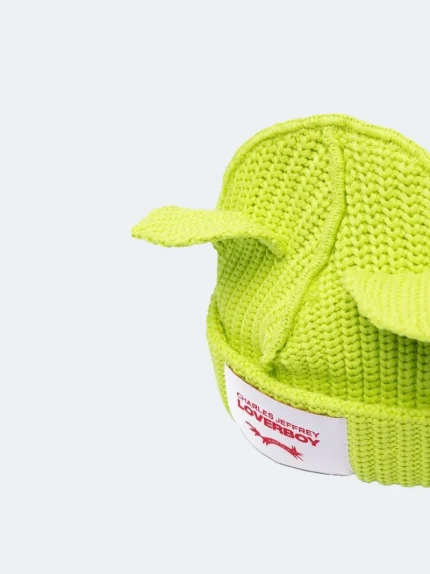The Loverboy Hat: A Bold Crown of Rebellion and Identity

Introduction: A Hat That Speaks Louder Than Words
In an era where fashion often dances on the line between conformity and individuality, the Loverboy hat stands out as a rebellious anthem woven into wool. This is no ordinary accessory. It doesn’t just shield you from the cold—it declares your stance, your attitude, your place in the world. Designed by Charles Jeffrey, the creative mastermind behind the brand Loverboy, this iconic hat is more than a piece of headwear. It’s a movement, a visual scream that dares to disrupt the norms of beauty, gender, and self-expression. With its whimsical horns and punk sensibility, the Loverboy hat isn’t trying to fit in—it’s here to provoke, to enchant, and to inspire.
The Origins: Charles Jeffrey’s Vision of Queer Utopia
To understand the Loverboy hat, one must step into the chaotic, colorful, and uncompromising world of Charles Jeffrey. A Scottish-born designer and graduate of Central Saint Martins, Jeffrey established Charles Jeffrey LOVERBOY as an extension of his vibrant artistic ethos. Deeply rooted in club culture, his brand was born from the sweaty dancefloors of East London and infused with the energy of queer nightlife. The Loverboy hat emerged from this space—a space where fashion meets performance art, and where clothing becomes a living, breathing extension of identity.
Jeffrey’s designs celebrate eccentricity and reject binary norms. The hat, with its signature horns, is almost mythological in nature. It feels like something conjured from folklore, yet modernized through a lens of queer liberation. Whether it draws from Scottish paganism or London’s underground rave scene, the hat channels a sense of powerful duality: part costume, part protest.
The Design: Horns, Wool, and Subversion
One glance at the Loverboy hat and you’re either intrigued or intimidated. Made predominantly from hand-knit wool or lambswool blends, the hat features two pointy, ear-like “horns” or protrusions at the top. These aren’t subtle—they’re exaggerated, whimsical, and unapologetically strange. But therein lies the magic. In a world addicted to minimalism and mass appeal, the Loverboy hat is maximalist, odd, and arrestingly personal.
Its construction is as tactile as it is symbolic. The knitted fabric invokes a sense of domesticity and tradition, yet the hat’s final shape distorts those associations. It takes something comforting and twists it into something disruptive. Colors range from muted earth tones to clashing brights and bold patterns—further accentuating the hat’s role as a wearable contradiction.
The hat often features bold graphic motifs—checkerboards, hearts, hand-drawn faces—all sketched in Jeffrey’s signature chaotic scrawl. Each design tells its own story, but collectively, they speak the language of defiance, queerness, and art-school rebellion.
A Symbol of Queer Expression
What truly sets the Loverboy hat apart is its embrace by LGBTQ+ communities as a powerful symbol of queer joy and resistance. It isn’t designed for quiet assimilation—it’s designed to be seen, to confront, to radiate pride. The horns themselves are a metaphor. Are they ears? Are they devilish protrusions? Are they fantastical antlers? The ambiguity is intentional. They allow the wearer to interpret their identity on their own terms.
Fashion has always had the capacity to be a political tool, especially for marginalized groups. The Loverboy hat aligns itself with that tradition. It offers queer individuals a means of being visible—of refusing erasure. When someone wears this hat, they’re not just participating in a trend. They’re declaring autonomy over their body, their style, and their story.
Fashion on the Fringes: The Hat in Streetwear and Runway Culture
Despite its origins in underground nightlife, the Loverboy hat has found a cult following among fashion-forward circles across the globe. High-profile artists, drag performers, fashion influencers, and even runway models have donned the hat with pride. It has been featured in editorial shoots, fashion week presentations, and avant-garde installations.
But the real magic happens in the streets. The Loverboy hat is not confined to the polished pages of magazines—it thrives in real-world chaos. Worn with oversized blazers, plaid skirts, fishnets, or combat boots, it lends itself to a variety of streetwear aesthetics. And in each context, it takes on new meaning. In Tokyo, it might read as Harajuku-inspired quirkiness. In Berlin, it may come off as punk rebellion. In London, it’s a badge of nightlife royalty.
The hat refuses to be static. It shapeshifts with the wearer, evolving into whatever visual narrative they wish to tell.
The Influence of Performance Art and Drag
Much of Charles Jeffrey’s inspiration comes from performance art, and that influence is particularly evident in the Loverboy hat. It’s a piece that begs to be performed. It encourages dramatics. It transforms the wearer into a character, a creature, a vision. Many drag artists have embraced the Loverboy hat precisely for this reason—it acts as a prop, a stage piece, a crown.
There’s a theatricality to the hat that resonates with queer history. Think of club kids in the ‘90s, glam rock stars in the ‘70s, or even early queer cabaret performers. The Loverboy hat belongs in that lineage. It is not only a fashion item—it is costume, armor, and celebration all at once.
Criticism, Controversy, and the Power of Polarization
No iconic fashion piece exists without its share of critics, and the Loverboy hat is no exception. Its exaggerated silhouette and high price point have drawn both confusion and scorn from those outside fashion’s more experimental circles. Detractors see it as gimmicky or unwearable. But that’s the point. It’s not meant to appeal to everyone—it’s designed to challenge expectations.
The hat’s very refusal to be commercialized in the traditional sense is part of its allure. It’s not trying to be your go-to winter accessory. It’s trying to be your favorite piece of wearable art. In that way, it proudly sits alongside the work of other fashion revolutionaries like Vivienne Westwood, Rei Kawakubo, and Alexander McQueen—all of whom created with the goal of provoking thought and emotion rather than just selling product.
The Emotional Connection: More Than Just an Outfit
For many who wear the Loverboy hat, the connection runs deeper than aesthetics. It becomes a kind of talisman—a piece of emotional armor that allows them to navigate the world with boldness. There’s something incredibly intimate about putting on a piece that makes you feel seen, especially in a society that often demands you shrink to fit in.
It’s common to hear wearers describe the hat as “empowering” or “liberating.” It gives them permission to be playful, loud, messy, and fully themselves. It taps into a childlike fantasy world where rules are rewritten, and joy is sacred. In that world, the Loverboy hat is not just a garment—it’s a gateway to self-love.
The Legacy: A Cult Classic in the Making
As fashion continues to oscillate between the bold and the bland, the Loverboy hat has cemented its place as a cult classic. It might not be a mass-market bestseller, but it wasn’t designed to be. Its value lies in its message—in its ability to make wearers feel brave, defiant, and beautifully different.
As more brands lean into sustainable and expressive design, the Loverboy hat serves as a reminder that fashion can still be radical. It can still be art. It can still make you feel like the most honest version of yourself.
Conclusion: Wear the Hat, Be the Revolution
The Loverboy hat isn’t for everyone. And that’s exactly what makes it special. It is for the dreamers, the rebels, the queer kids who grew up with glitter in their veins and fire in their hearts. It is for those who understand that clothing isn’t just about fabric—it’s about identity. It’s about voice. It’s about showing up in the world as the loudest, boldest version of yourself.
So wear the hat. Let it speak for you. Let it howl with you. Let it remind you that fashion isn’t just about fitting in—it’s about standing out with pride.



